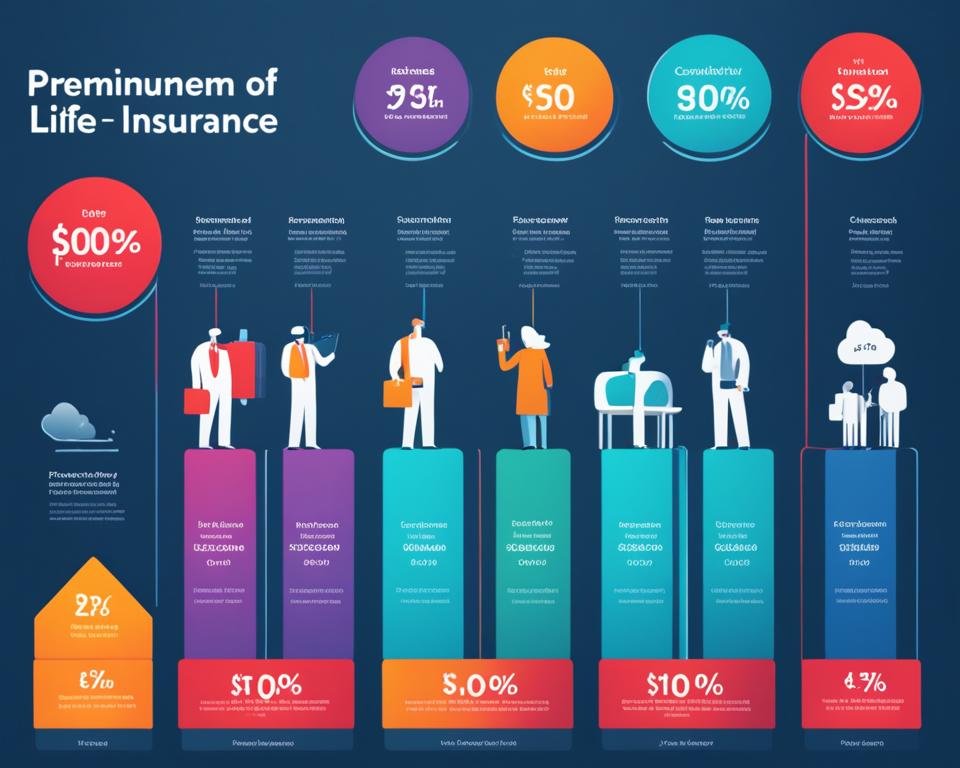I’m excited to share essential info on life insurance with you.1 My goal is to help you understand your options. This way, you can confidently choose what’s best for you. You can trust the details I’ll provide thanks to my strict editorial guidelines.
Many people wait to get life insurance until they really need it. This often happens when their lives start connecting with others. For example, it might be when they marry, buy a home, or welcome a child.1 Even though these moments push us to act, buying life insurance can still feel overwhelming. This guide aims to make the process clear and easy for you.
Key Takeaways
- Understand the different types of life insurance policies, including term, whole, and universal life.
- Explore the key terminology associated with life insurance, such as term length, death benefit, and policy roles.
- Learn about the importance of beneficiary designations and the distinction between primary and contingent beneficiaries.
- Discover the concept of insurable interest and how it impacts life insurance coverage.
- Delve into the underwriting process and how it affects your policy premiums and risk classification.
Exploring Different Types of Life Insurance Policies
Life insurance comes in different types. It’s important to know the differences. This understanding helps you choose the right one for your needs and budget.
Term Life Insurance: The Temporary Solution
Term life insurance lasts for a set time, like 10 to 40 years.2 If you die within this time, your loved ones get money. The insurance cost stays the same throughout the term.2
Permanent Life Insurance: Lifelong Coverage Options
Permanent life insurance lasts your whole life.3 It’s more costly and complex than term. There are whole life and universal life types.
Whole Life Insurance: A Closer Look
Whole life insurance guarantees a death benefit and grows cash value.3 Costs can go up as you get older. It may also include different categories like universal and variable life.
Universal Life Insurance: Flexibility Meets Protection
Universal life provides flexibility in payments and benefits. It balances protection and investment.3 As long as you pay, it covers you for life. Plus, it can grow cash value for the owner or heirs to use later.3
Understanding Key Life Insurance Terminology
As you learn about life insurance, it’s key to know some important terms. Knowing about term length and death benefit is vital. This knowledge will guide you in making wise choices.4
Term Length: The Duration of Your Coverage
Term length shows how long your life insurance lasts if you keep paying. It usually covers you for 10, 20, or 30 years. This is term life insurance.4 Whole life insurance, however, lasts your whole life. It’s a type of permanent life insurance.4
Death Benefit: The Financial Payout
The death benefit is a sum your loved ones get when you pass away. It’s the main reason people get life insurance. It helps your family financially, covering bills and debts.5 It makes sure your family is financially stable after you’re gone.5
Policy Owner and Insured: Roles Explained
The policy owner buys the policy and pays the premiums. They can change details in the policy. Like, they can pick who gets the money or even end the policy.4 The insured is the one who the insurance covers. If the insured dies, the beneficiaries can claim the death benefit.4
Life Insurance Basics: Navigating Beneficiaries
The beneficiary is key in life insurance. They get the money after the insured person dies.6 Usually, people pick their spouse, kids, or another family member as the main beneficiary.6 You can also name someone else to get the money if the first choice can’t.
Primary Beneficiaries: Your First Choice
You pick your main beneficiary first. It could be one person, like your spouse, or several people, each getting some money.6 You can even choose a charity. This way, your policy benefits something you care about even after you’re gone.
Contingent Beneficiaries: Backup Recipients
If the main beneficiary can’t get the money, the contingent one does. It’s a backup plan for who receives the payout.6 It’s important for smooth money distribution, especially if something unexpected happens.6 And remember, you can always change who you pick, especially after big life changes, like getting married or divorced.

Insurable Interest: A Crucial Concept
In the world of life insurance, insurable interest matters a lot. It means one person must show the death of another would hurt them financially. This rule helps life insurance policies do what they’re supposed to.
People with insurable interest might include a lot of family, like spouses, children, or parents. Even some employers can have an interest in their employees’ lives in certain cases. There are special rules for parents buying insurance for kids.7
The one being insured also needs to care about the policy owner’s well-being. An insurance company won’t sell a policy without this proof. Trying to get a policy on someone you don’t actually worry about is not okay.7
This idea of insurable interest helps stop fraud. It makes sure insurance is about helping real losses, not making money off someone’s death. Insurance companies have clear ways to check if there’s a real interest between the people involved. If they find something suspicious, they ask for more info. They want to be sure the relationship is real.8
So, insurable interest is key when you want to insure someone under a life policy. It makes sure the policy is for the right reasons. Understanding and following these rules helps families get the support they need if something happens to a loved one.9
Premiums and Risk Classes: Pricing Your Policy
Life insurance is all about knowing how much you’ll pay in premiums. A premium is what you pay for your coverage. You can pay it monthly, quarterly, semi-annually, or yearly.10
Understanding Premium Payments
Many things affect how much your life insurance costs. This includes your age, health, and lifestyle. The type of policy and amount of coverage matter too. Usually, term life insurance costs less than permanent life insurance.
For example, a 30-year-old might pay between $18.83 and $34.56 a month. This is for a $500,000 20-year term life policy, depending on health and other factors.10
Risk Classes: Determining Your Rate
Underwriting is the process the insurance company uses to check your risk. They sort you into risk classes like preferred, standard, or substandard. This is based on health, habits, and more.104 Healthier people often get lower premiums in preferred classes. But those at higher risk might pay more in substandard classes.10
Your risk level plays a big role in setting your insurance price. Knowing about these risk classes can help you pick the right coverage at the best price.4

The Underwriting Process: Behind the Scenes
The underwriting process is key in life insurance. It decides your coverage and cost. Insurers look at many things to decide your risk level and the right insurance class for you.11 This step often takes around four weeks. But, thanks to quick life insurance options and tech progress, you can get some policies the same day you apply.11
Medical Examinations and Health History
Insurers check your medical background during underwriting. They look at your age, gender, overall health, and family health. This info helps them know if they need a medical exam. The exam checks things like your weight, blood pressure, and runs some tests. Good results from these tests can lower your premiums.12 They also look into your activities, job, driving record, and past alcohol or drug use. This shows them your total risk level.11
Financial and Lifestyle Factors
How your finances match with your life insurance is very important. Insurers check your earnings, what you own and owe, and your credit. This helps them set the right coverage for you.13 They also think about your foreign trips, if you have other policies, and military service. This gives them a full picture of your risk.11
After looking at all this, underwriters use a unique formula to make their decision. They decide if you can get the coverage and what your premiums will be. You might be put into different risk categories, like Preferred Plus or Substandard. This changes how much your insurance costs.13
Thanks to new tech like artificial intelligence, things are moving faster. Some companies now offer quick underwriting. This means some people get approved without a medical exam, same day. But, the cost for these policies might be more, since the insurer knows less about you.13
Knowing how life insurance underwriting works can help you be ready. It’s good to understand how to get the coverage that matches your needs and risk.
Policy Riders: Customizing Your Coverage
Riders change your life insurance policy to fit your special needs. They are additional choices you can add. These choices help you make your insurance just right for you.14
Waiver of Premium Rider
This rider is very important. It lets you stop paying if you can’t work because of a disability. Your policy stays active even if you aren’t paying.151614
Accidental Death and Dismemberment Rider
For extra cover in accidents, think about the AD&D rider. It pays more if you die or lose a limb due to an accident.1514 Jobs that are risky or if you’re very active, it helps keep your family safe financially after an accident.
Adding riders can make your premium more expensive. But, sometimes they don’t cost more at all.1614 Be sure to pick riders that suit your insurance needs. Think about each one before adding it to your policy.

Life Insurance Basics: Cash Value and Dividends
Cash Value: A Growing Asset
If you own a whole life or universal life insurance, part of your payment builds a cash value with interest.17 This growing cash value can be used for loans or withdrawn, depending on your policy’s terms.17
Dividends: Sharing in the Profits
Some life insurance companies share their profits with policyholders through dividends.18 You can get these dividends as cash, use them to lower your premium, add to the cash value, or buy more insurance.1819
The life insurance cash value and life insurance dividends from permanent policies are key benefits. They let you use saved funds or enjoy the insurer’s success.

Conclusion
This guide has covered the basics of life insurance. We looked at various policy types, important terminology, and how to choose beneficiaries. We discussed premium costs, the underwriting process, and riders. We also talked about the value of cash value and dividends.4 Knowing all this helps you pick the best policy for your family’s protection.
It’s important to act now on your insurance needs.20 You might go for a term life insurance for cost reasons. Or you may prefer permanent life insurance for the lifelong benefits it offers. Always check your insurance needs as life changes.20
Feel free to ask for help if you’re unsure about life insurance. Talking to experts can make sure you’re on the right track. They’ll help you protect your family’s future the best.20
FAQ
What is term life insurance?
What are the main types of permanent life insurance?
What is the term length and death benefit in a life insurance policy?
Who are the policy owner and the insured?
Who are the beneficiaries in a life insurance policy?
What is insurable interest?
How are life insurance premiums determined?
What is the underwriting process for life insurance?
What are life insurance riders?
What is the role of cash value and dividends in life insurance?
Source Links
- https://www.quotacy.com/life-insurance-claims-for-a-missing-person/
- https://www.nerdwallet.com/article/insurance/types-of-life-insurance
- https://www.iii.org/article/what-are-principal-types-life-insurance
- https://www.investopedia.com/terms/l/lifeinsurance.asp
- https://www.iii.org/article/life-insurance-basics
- https://www.securian.com/insights-tools/articles/naming-a-life-insurance-beneficiary.html
- https://www.protective.com/learn/what-is-insurable-interest-in-life-insurance
- https://www.forbes.com/advisor/life-insurance/what-is-an-insurable-interest/
- https://www.bankrate.com/insurance/life-insurance/insurable-interest/
- https://www.quotacy.com/what-is-life-insurance/
- https://www.nerdwallet.com/article/insurance/life-insurance-underwriting
- https://www.lgamerica.com/life-insurance/basics/what-is-underwriting
- https://www.bankrate.com/insurance/life-insurance/underwriting/
- https://www.nerdwallet.com/article/insurance/life-insurance-riders
- https://www.protective.com/learn/life-insurance-riders
- https://www.investopedia.com/articles/pf/07/life_insurance_rider.asp
- https://www.investopedia.com/terms/c/cash-value-life-insurance.asp
- https://www.newyorklife.com/resources/life-insurance-101
- https://www.investopedia.com/terms/w/wholelife.asp
- https://www.manning-napier.com/insights/an-introduction-to-life-insurance
